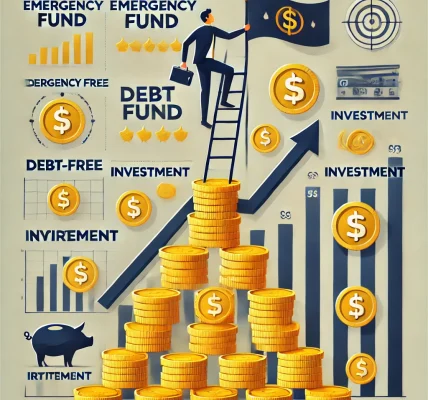Introduction
Retirement is one of the most significant financial milestones in life. To ensure a comfortable and stress-free future, proper planning is essential. Many people delay retirement planning, assuming they have enough time, but starting early can make a significant difference.
In this comprehensive guide, we will explore key steps to secure a financially stable retirement, helping you build wealth, reduce financial stress, and enjoy your golden years.
Why Retirement Planning is Crucial
1. Financial Independence
A well-planned retirement ensures that you do not have to rely on others for financial support in your later years.
2. Rising Cost of Living
Inflation increases the cost of goods and services over time, making it essential to save and invest wisely to maintain your standard of living.
3. Medical Expenses and Healthcare Needs
With age, healthcare costs rise. Proper financial planning ensures you can cover medical expenses without draining your savings.
4. Uncertainty of Social Security and Pension
Depending solely on government or employer pension plans may not be sufficient. Personal savings and investments play a key role in financial stability.
Steps to Secure a Comfortable Retirement
1. Start Early and Leverage Compounding
The earlier you start saving and investing, the more you benefit from compound interest. Even small contributions made consistently over time grow significantly.
2. Set Clear Retirement Goals
- At what age do you want to retire?
- What lifestyle do you envision post-retirement?
- How much money will you need annually?
Calculating these factors will help you set a realistic savings target.
3. Create a Retirement Budget
Understanding future expenses will help you determine how much you need to save. Your retirement budget should cover:
- Housing (mortgage or rent, maintenance, utilities)
- Healthcare (insurance, medications, treatments)
- Daily living expenses (food, transportation, entertainment)
- Travel and hobbies
4. Utilize Retirement Savings Accounts
Different retirement accounts offer tax advantages and growth opportunities. Some popular options include:
- 401(k) Plans: Employer-sponsored plans often include contribution matching, making them an excellent savings vehicle.
- Individual Retirement Accounts (IRAs): Traditional and Roth IRAs offer tax advantages to boost retirement savings.
- Pension Plans: Some companies provide pensions, but it’s essential to understand payout terms and eligibility.
5. Diversify Investments for Growth and Stability
Investing wisely ensures your savings grow over time. A well-diversified portfolio should include:
- Stocks (higher risk but potential for high returns)
- Bonds (lower risk, steady income)
- Mutual Funds and ETFs (professionally managed, diversified options)
- Real Estate (long-term asset value growth)
6. Reduce and Eliminate Debt
Paying off debts before retirement helps preserve your savings. Prioritize:
- Credit card debt (high-interest rates)
- Mortgage (consider downsizing if necessary)
- Personal loans and auto loans
7. Plan for Healthcare and Insurance Needs
Medical expenses can be a major financial burden. Consider:
- Health Insurance: Ensure coverage through Medicare, private insurance, or employer-sponsored retiree plans.
- Long-Term Care Insurance: Helps cover expenses for assisted living or nursing home care.
8. Increase Retirement Contributions Over Time
As your income grows, increase your contributions to retirement accounts. Even a small percentage increase can have a substantial impact over time.
9. Consider Passive Income Streams
Generating passive income can supplement retirement savings. Options include:
- Rental properties
- Dividend-paying stocks
- Annuities
- Side businesses or freelancing
10. Create an Emergency Fund
Unexpected expenses can arise anytime. Maintain an emergency fund with 6-12 months’ worth of living expenses separate from your retirement savings.
11. Review and Adjust Your Plan Regularly
Retirement planning is not a one-time task. Regularly reviewing your savings, investments, and financial goals ensures you stay on track.
12. Seek Professional Financial Advice
A financial advisor can help tailor a retirement plan to your specific needs, ensuring tax efficiency and optimal investment choices.
Common Mistakes to Avoid
1. Procrastination
Delaying retirement savings reduces the benefits of compounding interest.
2. Underestimating Expenses
Failing to account for inflation and medical costs can lead to financial shortfalls.
3. Relying Solely on Social Security
Government benefits may not be enough to sustain your desired lifestyle.
4. Making Risky Investments Close to Retirement
Avoid high-risk investments as you near retirement to protect your savings from market fluctuations.
5. Not Accounting for Longevity
Many people underestimate how long they will live, leading to financial insecurity later in life.
Conclusion
Retirement planning is a long-term commitment that requires careful budgeting, disciplined savings, and smart investments. By starting early, setting clear goals, and making informed financial decisions, you can ensure a comfortable and financially secure retirement. Take charge of your future today to enjoy peace of mind in your golden years.




